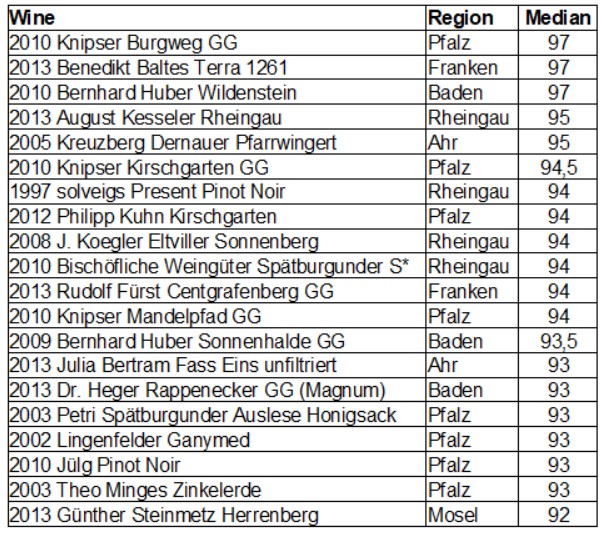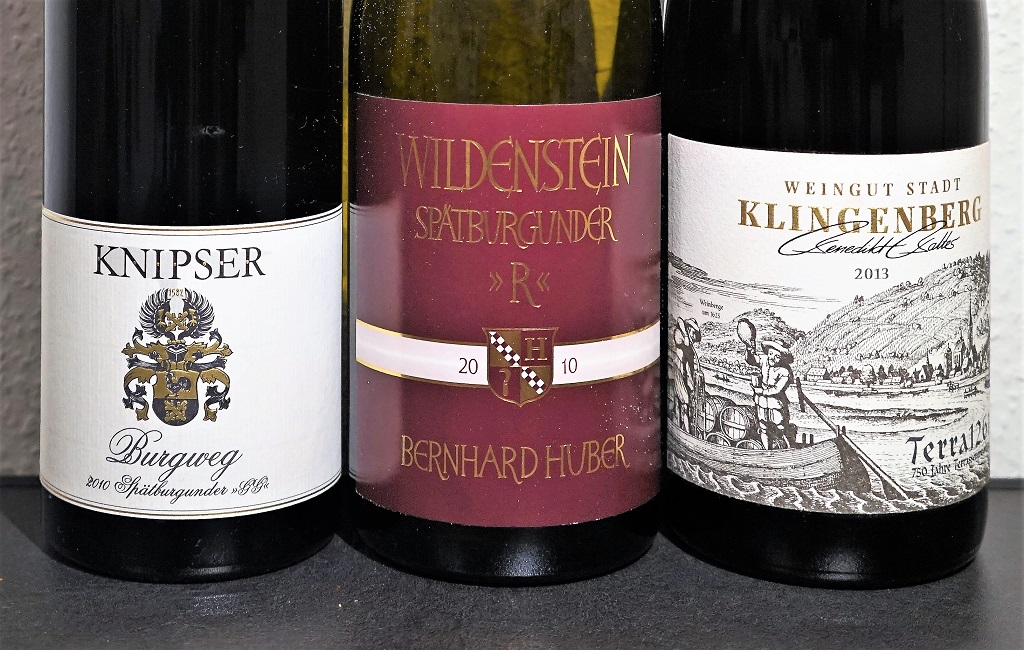German Pinot Noir – Back To Successful Roots
History

“September 11th Klicken Eberts and others shipped barrels to Erden, he drunk so much of the new red wine that he fell from the barrels into Mosel River and drowned, he is burried at Erden”
Register of deaths, 1599, September 11th, Protestant Parish, Wolf an der Mosel, English translation of German text by JAJ Kaiser, Document courtesy of Dr. Christof Krieger, Mittelmosel-Museum, Traben-Trarbach
Looks like the quality of Pinot Noir shipped 1599 on the Mosel River was so good, that Eberhart Klick, one of the boatmen, drunk more than his due share, fell into the river and drowned.
Pinot Noir has a long and outstanding tradition in Germany. Even in regions we regard as typical white wine hotspots, like Mosel with its predominant Riesling nowadays. German Pinot Noir was much valued abroad and therefore shipped along Mosel, Main, Neckar and finally Rhein River, mainly to northern Europe.
That’s history. During the following centuries white wine from Germany, mainly, and more and more Riesling, became the rising star on European royal tables. Everybody who could afford it showed off with German white wines. They were the most expensive wines worldwide. For example, until 1936 every Noble Prize dinner served German white wines. The Nazis took over and internationally, German whites were history, too.
After World War II nearly nobody wanted to buy wine from the German pariah. Finally, the prices dropped, many vintners were either forced out of business or had to join bigger cooperatives which followed a moderate quality approach at best. In contrast to France, no strong appellation movement emerged, only the mediocre suger based 1971 German wine law. Furthermore the prestigious single vineyards were devaluated by grouping lesser sites under the same name. Origin was not valued high any longer. Champagne, Burgundy’s Chardonnays and Pinot Noirs, as well as Bordeaux’s sweet white and dry red wines became unchallenged top of the pops.
How excellent German Pinot Noirs performed, even after 1945, showed an enlightning tasting. FINE magazine (1/2009) compared Pinot Noirs from Assmannshäuser Höllenberg (Rheingau) with top Burgundian Pinot Noirs (DRC, Remy, Van der Meulen and others) covering vintages from 1959 to 1921. It showed that Assmannshäuser Spätburgunder was at least on par with Burgundy’s finest.
Tastings
Today we are witness to a shift once again. Let’s not call it a landslide, but internationally German wines are back again. There are even sommeliers who have Riesling tattooed on their skin. And for sure Spätburgunder, which is the German name for Pinot Noir, is also on the rise, achieving a lot of international attention lately. There is no sommelier we know of who has Spätburgunder tattooed on his skin, not yet, but let’s see.

Cyprus and New York based sommelier Georgios Hadjistylianou loves Riesling (and Pinot Noir)
Photo courtesy of Georgios Hadjistylianou, mod. VINOSITAS Photography
We, that’s a group of wine journalists, vintners and educated wine enthusiasts, decided to have a more recent overview of German Pinot Noirs. Some Pinot Noirs in our tastings were selected because they were enthusiastically perceived in the German wine world, but mainly because they scored high in our personal as well as in our friends previous tastings. In the end 40 Pinot Noirs, 33 German ones, 4 from Burgundy, 2 from Switzerland and 1 from Oregon were arranged in four tastings, November and December 2016.
People might claim that some producers of top German Pinot Noirs are missing, like Friedrich Becker (Pfalz) or Jean Stodden (Ahr), and our selection of German Pinot Noirs is erratic. That’s neither here nor there, our aim was not to have all high-end or a completely regional representative sample of German Pinot Noirs. But we definitely had a broad overview with many renowned wineries and lots of not so well-known ones. Add a dozen more wineries, it won’t change the general picture.
Two tastings were devoted to vintages, 2010 and 2013, one to vintages 8 – 20 years old, and one consisted of all other wines we selected. We opened the bottles the evening before the tasting to check for wine faults and to give the wines a little bit of breathing air. At each tasting we knew which wines we would taste. But all wines were served blindly in random order and rated, first. We had a second open tasting about three hours later to check whether or not the wines evolved with time and air.
Results

Top 20 German Pinot Noirs of our tastings (median points/100)
The quality level was very high. After three hours of breathing air all wines held firm, a few even evolved and scored a little bit higher by a maximum of one or two points.
In the top range were three wines, which are not listed in the statistics above as they are not German. Among the top 10 was 2004 Le Cellier des Ursulines Clos des Angles Volnay Premier Cru, and among the top 20 was 1997 Château des Jacques Clos des Thorins Moulin-à-vent. The Moulin-à-vent is not a Pinot Noir but Gamay, the usual pirate in a tasting, demonstrating how excellent old Gamay can age. 2010 Domaine Chambleau Pur Sang, a Pinot Noir from Switzerland’s Lac de Neuchâtel, was also among the top 10.
Prices
Prices of our top 20 wines ranged from 15 Euros/bottle to eight times that much at 120 Euros/bottle. But quality wise from the top three wines to the four last in our top 20 range it’s only 5 points difference. You can’t say you have to pay astronomical prices for top wines. At 37 Euros even our number one German Pinot Noir, Knipser’s 2010 Burgweg GG, is reasonably priced.
-
Most top German Pinot Noirs are still a bargain, especially if you don’t go for vintners everybody knows.
Quality

Top 3 German Pinot Noirs of our tastings
Looking at the best Pinot Noirs of our tastings, what do they have in common? While there is no easy answer to this question, some elements are common to all of them: First, of course, they are complex, expressive, deep, and show substance from the nose to the finish. Second, the balance of alcohol, tannins and fruit is very good to outstanding in all Top 20 Pinot Noirs.
-
German Pinot Noir is back to its successful roots. Top ones are world-class again.
2010 and 2013 were two vintages we examined further in our tastings. In general 2010 was regarded as a mediocre vintage in Germany. A cool year with really high acidity levels, which was not enthusiastically perceived by the critics. 2009, 2011 and 2012 were the opposite, and 2013 was cooler again. It is pretty clear that what might be true for some other red varieties isn’t necessarily true for Pinot Noir. The warmer and drier years might enable charming, full-bodied Pinot Noirs, but the really well balanced Pinots can frequently be found in the cooler vintages. For top producers who knew what to do 2010 proofed to be the perfect Pinot Noir year in Germany. Not surprisingly, many of our best Pinot Noirs are from 2010. With their vibrant youth, their mouth-watering finesse, transparency and ageing potential, they display what Pinot Noir is traditionally renowned for. Not far behind is 2013, just have a look and you’ll find 7 out of our top 20 wines are from this vintage.
It’s no surprise that among our top 20s several internationally renowned producers can be found, Fürst, Heger, Huber, Kesseler, Knipser and Kreuzberg. Baltes, Bischöfliche Weingüter, Jülg, Koegler, Kuhn, Minges and Steinmetz might sound familiar to wine professionals. But who has ever heard of Bertram, Petri, solveigs or Lingenfelder? Meanwhile there are so many German vintners throughout all wine growing regions producing good to outstanding Pinot Noirs, it’s a real miracle:
-
While some critics claim that breadthwise Burgundy’s Pinot Noirs as such are overrated, we find that German Pinot Noirs can’t be rated highly enough.
Style
We knew we would face different styles of Pinot Noir. Nevertheless we were completely surprised how different they were. There were elegant-transparent ones, several were veritable power packs, some expressively fruity, some more on the spicy side, coolish-minty-ethereous, or with a mineral touch and everything in between. No way to find a common denominator, besides the fact that all 20 wines were complex, and excellent to outstanding.
It clearly shows that German vintners during the last 30 years did not only do stints in Burgundy to study Pinot Noir wine making, but also went to the USA, New Zealand, Australia and South Africa to get the best of new world wine making. Some German Pinot Noirs may be as fruity as an Australian Cabernet or as powerful as a Californian Zinfandel, but they will never be adipose, having nice acidity to keep a mouth-watering freshness and a certain elegancy – just call it balance.
-
It’s hard to imagine such a diversity of excellent Pinot Noirs anywhere else. No problem to find your favorite style among German Pinot Noirs.
Style of Pinot Noirs did not depend on region. Baden is Germany’s warmest, most southerly region, summer temperatures climbing up to 38°C/100°F or even 40°C/104°F. Huber and Heger wines, which are from the most southerly part of Baden, neither were more powerful nor did they have more alcohol than the other wines. The same applies to any other characteristic, be it fruitiness or acidity. No way to reason from style to region.
The tastings revealed that usage of new oak, barriques or larger barrels, differs broadly. But that’s not a matter of region since it’s just the vintner’s choice. It also showed how well German vintners have learned to integrate oak.
-
Style is not dominated by region, but by the vintner’s individual signature and to some extent by vineyard site characteristics.
Future
In many family-owned wineries the post-war generation already passed the baton on to their daughters and sons. In others this process is right underway. The young generation has an excellent education at wine universities and professional training at top wineries. They travel a lot to learn from renowned vintners in other countries, feeling what’s going on world-wide. They have an extensive network of fellow students and colleagues, which they use for mutual support and cooperation. Some are very young like Julian Huber or the Petri bros in their early 20ies. And some focus mainly or even completely on Pinot Noir like Julia Bertram and Benedikt Baltes.
No doubt, many Pinot Noirs from young vintners we did not have in our tastings would not have had any problem to compete with our selection. For example, Sven Enderle & Florian Moll’s Buntsandstein and Muschelkalk Pinot Noirs, or Dirk Würtz’s Balthasar Ress Caviar Pinot Noir are exceptional, highly individual wines. Another example is Oliver Gabel’s Honigsack Spätburgunder, which is not as freaky as others. Aromas are more on the classic Pinot Noir side, but also excellent quality wise.
During the last 15 years Pinot Noir in Germany became a vine on steroids. Area under red vine grew rapidly up to 35%, mainly Pinot Noir. Today Germany is the world’s third largest producer of Pinot Noir. Investment in Pinot continues to be high. There are not only new plantations, it’s intriguing that some old, forgotten and abandoned historical sites are replanted, too.
- There is no shortage of young, ambitious Pinot Noir producers in Germany. Investments are high and the future looks bright.
Text: Joachim A. J. Kaiser, Thorsten Kogge
Photos: VINOSITAS Photography Joachim A. J. Kaiser, Georgios Hadjistylianou
